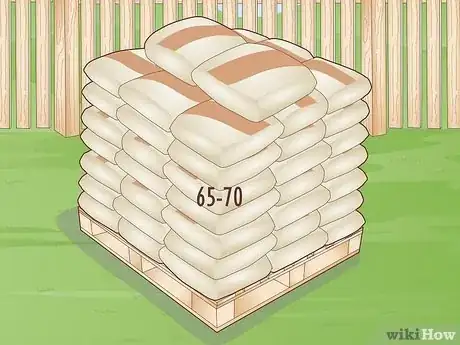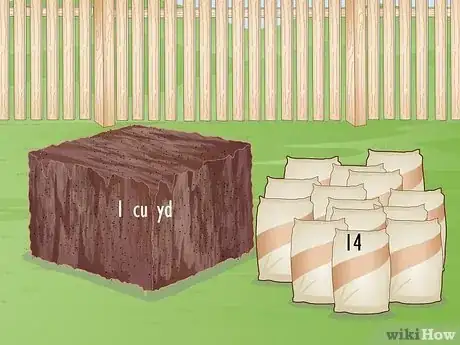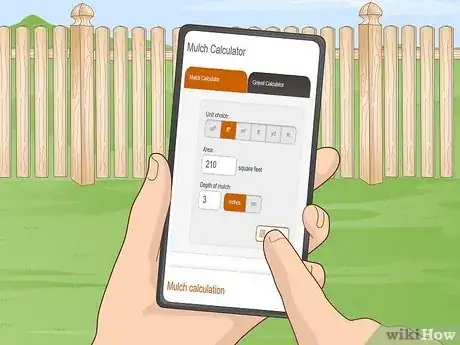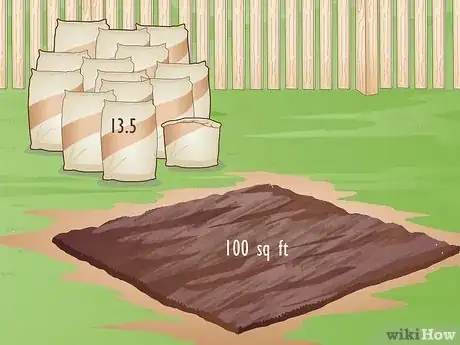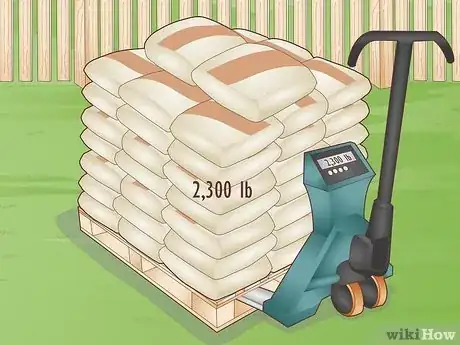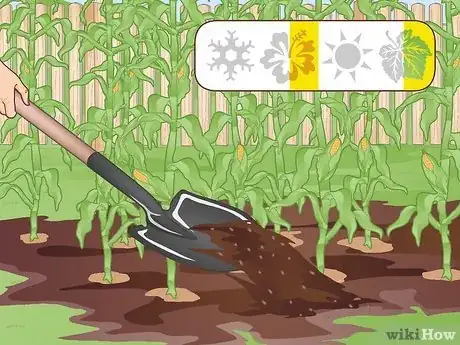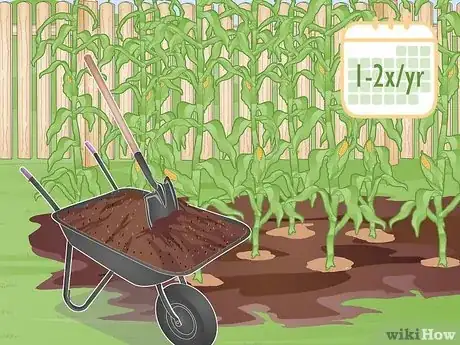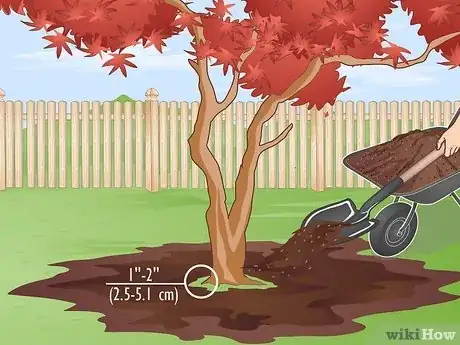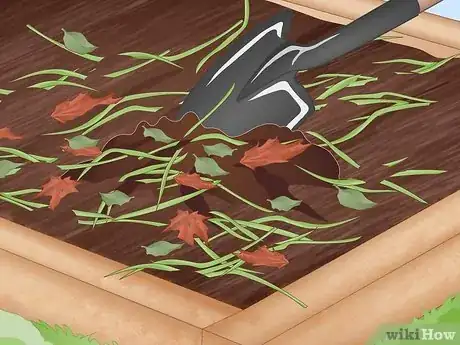This article was co-authored by Steve Masley and by wikiHow staff writer, Christopher M. Osborne, PhD. Steve Masley has been designing and maintaining organic vegetable gardens in the San Francisco Bay Area for over 30 years. He is an Organic Gardening Consultant and Founder of Grow-It-Organically, a website that teaches clients and students the ins and outs of organic vegetable gardening. In 2007 and 2008, Steve taught the Local Sustainable Agriculture Field Practicum at Stanford University.
There are 8 references cited in this article, which can be found at the bottom of the page.
This article has been viewed 1,592 times.
Purchasing an entire pallet of bagged mulch can definitely save you money versus buying individual bags. But how many bags are on the pallet? And just how many bags do you need for your project? We can help you answer those questions, plus we’ve thrown in some mulching advice for your landscaping project. So, instead of trying to count mulch bags on a pallet, count on us!
Things You Should Know
- Expect to get about 65-70 average-size bags of mulch on a standard-size pallet—but confirm this with the seller, because definitions of a “full pallet” vary widely.
- Plan to use about 13 bags of 2 cu ft (0.057 m3) mulch for 100 sq ft (9.3 m2) of coverage at a 3 in (7.6 cm) depth.
- Add mulch 1-2 times per year for the best results, but make sure to keep mulch from piling up against the bases of trees and other plants.
Steps
How many bags of mulch do I need?
-
1Use an online mulch calculator to simplify the process. If you’d rather do more mulching and less math, find a good online mulch calculator. Simply input the area you plan to cover (in square feet or square meters) and your intended mulch depth (in inches or centimeters), then let the calculator determine how many bags you’ll need.
- For example, if you input 210 sq ft (20 m2) at 3 in (7.6 cm), a mulch calculator will tell you to buy 26.3 [2 cu ft (0.057 m3)] bags. (But buy 27 or, better yet, 28 to be sure you have enough mulch!)
- If you’re dealing with an irregularly-shaped space that makes it hard to measure the area, do your best to estimate the area to be covered. An educational site that helps students estimate the area of irregular shapes can be a really helpful resource.
-
2Estimate 13.5 bags per 100 sq ft (9.3 m2) to do the calculations yourself. The landscaper’s rule of thumb is to estimate 1 cu yd (0.76 m3) of mulch—or 13.5 [2 cu ft (0.057 m3)] bags—for every 100 sq ft (9.3 m2) at a depth of 3 in (7.6 cm). So use that as the baseline for your calculations.[4]
- For example, a 6 ft × 8 ft (1.8 m × 2.4 m) planting bed equals 48 sq ft (4.5 m2). So you’ll need 0.48 cu yd (0.37 m3) of mulch, or about 7 standard bags (0.48 x 13.5 = 6.48), to cover it.
- For a deeper layer than the typical 3 in (7.6 cm), measure all three elements (length, width, and depth) in feet to get a cubic footage estimate, then convert it to cubic yards by dividing by 27 (or multiply by 0.000001 to convert from cubic centimeters to cubic meters). For example:
- 8 ft (L) x 6 ft (W) x 0.5 ft (D) = 24 cubic feet; 24 / 27 = 0.89 cubic yards; 13.5 x 0.89 = 12 standard bags of mulch.
- What if you want to mulch a circular area, like around a tree? Measure the radius (half the diameter), then use the formula to get the area:
- If r = 4 ft (1.2 m), A = 3.14 x 16 = 50.24 sq ft (4.667 m2)
Mulching Advice
-
1Mulch in late spring to add nutrients and in late fall to protect plants. Mulching doesn’t just limit weeds and hold in moisture—it also adds nutrients to the soil as it decomposes. Additionally, when the weather turns cold, mulch serves as a sort of blanket to moderate rapid temperature changes, which can be harmful to your plants.[7]
- To get the most out of the nutrients mulch provides, add a 2–4 in (5.1–10.2 cm) layer when your plants are just beginning their robust growth period—usually in late spring or early summer.
- Add about 4–6 in (10–15 cm) of mulch after the growing season is over and the cold weather begins to arrive to provide your plants with a blanket.
-
2Refresh your mulch beds 1-2 times per year. Any type of mulch made of organic material—wood, straw, leaves, etc.—naturally decomposes over time, so you’ll just end up with more dirt if you don’t refresh the mulch bed. Annual mulching is usually sufficient to keep the bed looking good year-round. Alternatively, add mulch in late spring for nutrients and late fall for temperature regulation.[8]
- You don’t need to remove the old mulch—just add a layer of new mulch on top.
- Mulches made of non-organic materials—like rubber mulch—will last much longer, as will landscaping alternatives like stone and gravel.
-
3Leave a 1–2 in (2.5–5.1 cm) gap when mulching around a tree trunk. Avoid the “mulch volcano” of built-up mulch right against the base of a tree, shrub, or other plant. Instead, when mulching around a tree or other plant, maintain a small ring of open air around the base to allow for proper drainage and airflow. Your plants will thank you![9]
- A “mulch volcano” holds moisture right up against the base of the plant, which invites fungal growth and attracts destructive insects. It also inhibits oxygen flow to the root system.
-
4Make your own mulch out of things like leaves and grass clippings. Buying bagged mulch is definitely convenient, but making your own mulch is a great way to save some money and repurpose yard waste. For the best of both worlds, blend together bagged mulch with some of your homemade stuff.
- To make leaf mulch, shred up a pile of leaves by running your lawnmower over it. If desired, sift out any larger pieces through a piece of wire fencing.
- Add grass clippings or even finely-shredded paper to your leaf mulch.
- Rent a wood chipper to turn yard waste like twigs and small branches into mulch.[10]
References
- ↑ https://www.evergladesfarmequipment.com/mulch/
- ↑ https://gomulch.com/collections/full-pallets
- ↑ https://savvygardening.com/mulch-calculator/
- ↑ https://savvygardening.com/mulch-calculator/
- ↑ https://whatthingsweigh.com/how-much-does-a-bag-of-mulch-weigh/
- ↑ https://pe.usps.com/qsg_archive/pdf/qsg_archive_20060108/qsg300/q705b.pdf
- ↑ https://www.bobvila.com/articles/mulching-the-garden/
- ↑ https://www.bobvila.com/articles/mulching-the-garden/
- ↑ https://www.youtube.com/watch?v=fI12XNNqldA&t=12s
